Search for answers or browse our knowledge base.
Can't find the answer you need here? Contact our support team and we'll gladly help you.
Portrait lead management home screen (with phone calls)
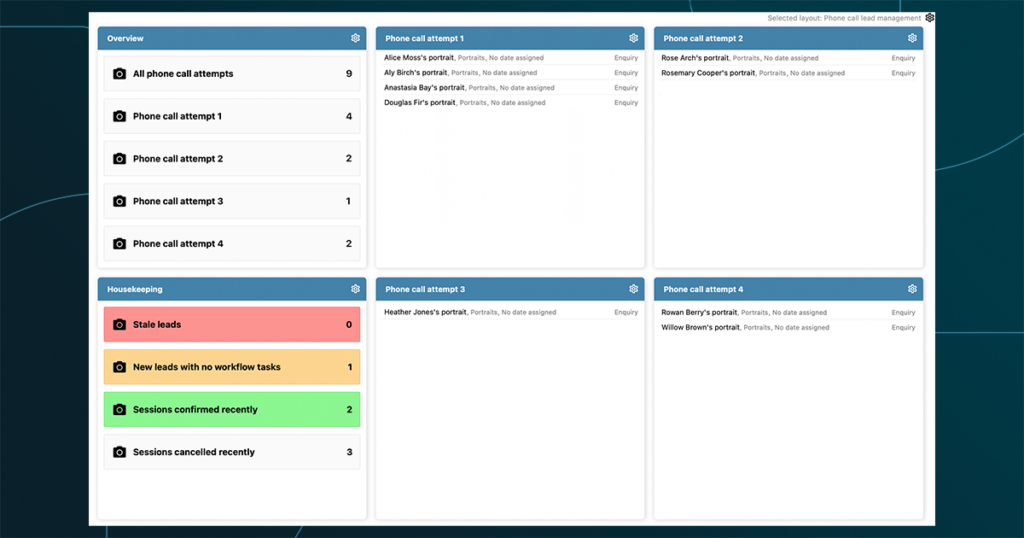
Why phone calls
Following up with leads by phone is a proactive way to convert them into clients. Calls are harder to ignore than emails, and a well-handled conversation can help build rapport and trust.
👉 Read our top tips for making successful calls.
Since it may take multiple attempts to reach a lead, having a structured process and a clear overview is essential. However, balance is key—too many calls can be counterproductive. A strategic, well-timed approach ensures the best results.
Lead sources
Photographers use a wide variety of marketing tactics in order to obtain new leads, including competitions, ad campaigns, in person events, and purchasing data. It’s possible to bring that lead data in to Light Blue from any source:
- Importing shoots & contacts from a CSV (spreadsheet),
- Facebook Lead Ads,
- Click Bump2Baby data,
- Contact forms on a landing page.
Shoot record vs Contact record
Some photographers choose to create just a contact record to represent a new lead, and then create a shoot at the point that our booking is made.
When trying to convert leads into bookings – especially when making phone calls that try to book the leads – we would recommend creating a shoot record (linked to a contact) when the new lead is acquired. This has a number of benefits:
- The shoot’s status will initially be “enquiry”, which makes it easy to see where each lead is up to.
- Light Blue can automatically apply a shoot enquiry workflow to the new shoot, which helps organise the lead management process
- When those leads converting into bookings, the shoots status will change to be “confirmed”, which will remove any outstanding tasks from the enquiry workflow.
- Similarly, when a lead says that they are no longer interested in hearing from you, marking the shoot as “cancelled” also removes any outstanding steps from your workflow.
- Shoots with the status of “enquiry” do not have to have a shoot date set right away. You can set a date and time for the session while you are speaking with the lead. You can also use scheduling requests to confirm the booking.
- Because shoot records have a Status field and an Enquiry source field, using shoot records to manage the process gives a clearer overview of how well those leads are converting.
The enquiry workflow
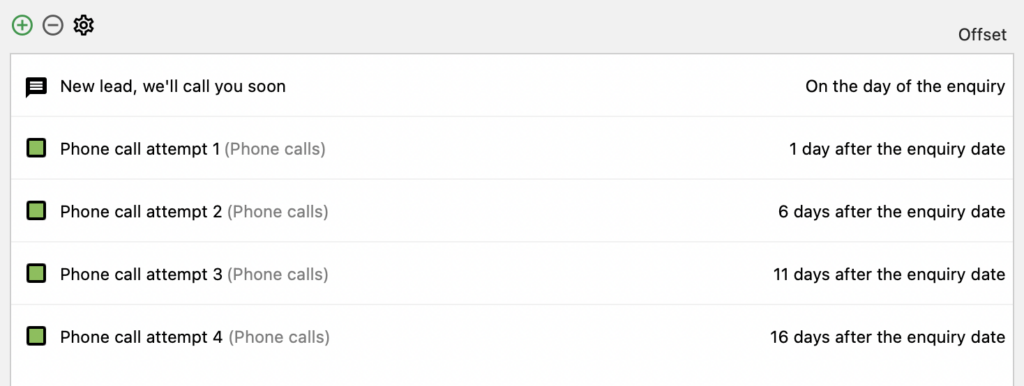
Here’s a suggested “Phone call lead management” workflow that would get added to the shoot record for each lead. It includes the following steps:
- A text message to let the lead know that we’ve got their details and to expect a call in the near future.
- A task for making the first phone call attempt.
- Another task for making the second phone call attempt.
- Other tasks for the third and fourth phone call attempts.
A copy of this workflow (without the text message) is included in the downloadable resources that are part of this article (below).
The phone call tasks are spaced 5 days apart from each other – you’re welcome to modify that to suit your needs.
The phone call tasks also have their own special task category, this makes it possible to filter and hide these tasks from your home screen task manager. This is helpful when you’re using a custom home screen to manage the phone call process, instead.
Tracking phone call lists using a home screen template
Here’s a home screen template that you can use to get an overview of all of your leads, and clearly see which ones need follow-up.
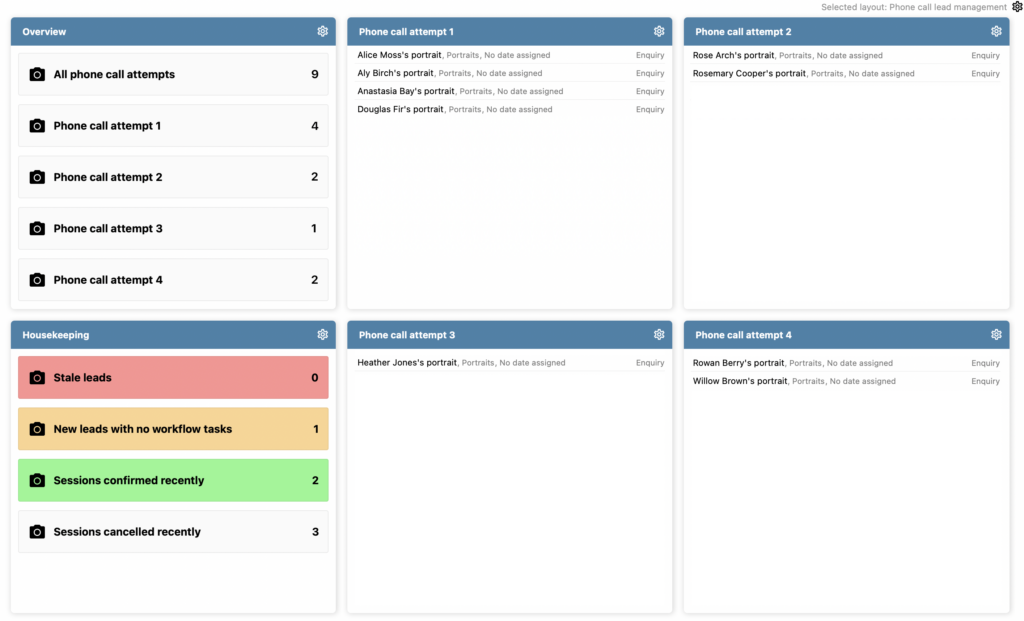
How it works
The “Phone call lead management” workflow includes 4 tasks:
- Phone call attempt 1
- Phone call attempt 2
- Phone call attempt 3
- Phone call attempt 4
The home screen template includes queries that find all enquiries whose next task contains specific words (e.g. “Phone call attempt 2”). The query isn’t concerned with when the task is due, since it’s unlikely that you’ll be making phone calls a specific number of days after you first obtained the lead; the due dates for the phone call tasks are arbitrary.




Once you have attempted to make a phone call, you can complete that “Phone call attempt” task. You would complete the task even if the call went to voicemail or the lead didn’t answer. You can also leave a note in the activity tab of the shoot to say that you’d left a voicemail, or send an email/text after calling, if you wish.
The enquiry will then move into the next “Phone call attempt” query, so you’re ready to try again.
If the phone call is successful and you proceed to booking the lead, the shoot status will get changed to “Confirmed” and all outstanding items in the enquiry workflow will be removed. Read more about the booking process, below.
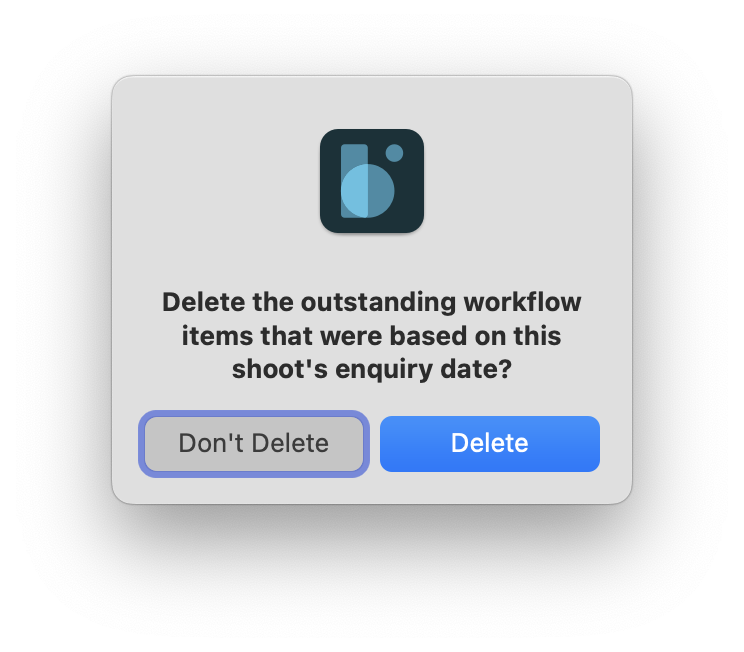
If you speak to the lead and they tell you they’re no longer interested in hearing from you, then you can mark the shoot as “Cancelled”, again all outstanding items in the enquiry workflow will be removed.
Once all phone call attempts have been exhausted, the lead will appear in the “Stale leads” query. Read more about handling stale leads, below.
Avoiding calling the same lead twice in one day
When you complete a “phone call attempt” task (e.g., “Phone call attempt 1”), the next scheduled attempt (e.g., “Phone call attempt 2”) will automatically appear. The phone call management home screen uses queries to find the next task in a shoot, so leads will immediately move into the “Phone call attempt 2” list after completing “Phone call attempt 1.”

To prevent calls from being scheduled too soon, we’ve added a filter that only includes shoots where the previous attempt was completed at least 2 days ago.
Installing the template
- Download the template file from here,
- Open Light Blue, click on the Records menu,
- Choose “Import”, then “Light Blue Templates”,
- Select the template file that you’ve downloaded.
You’ll find the imported home screen by clicking on the options cog in the top right hand corner of the home screen, choosing “Select Home Screen Layout”, then choosing the home screen.
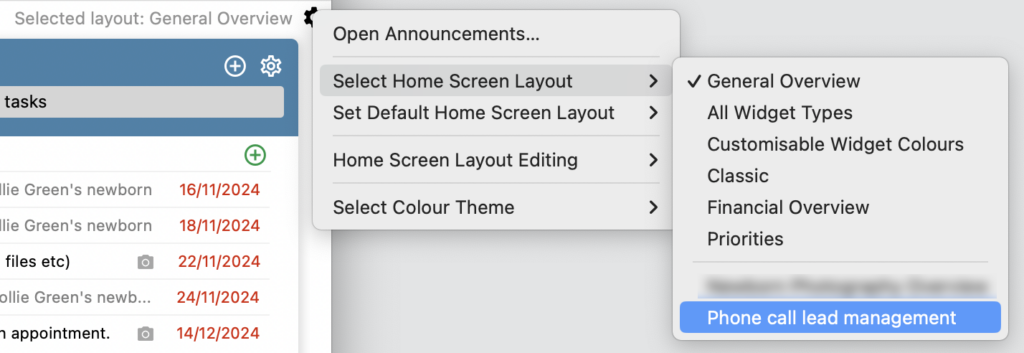
You’ll also find a “Phone call lead management” workflow within your workflow preferences. You can manually select this workflow whenever you add a new enquiry, or you can set it as the default workflow for a particular shoot type by:
- Opening the Workflows preferences,
- Selecting the “Phone call lead management” workflow,
- Clicking on the “Set defaults” button,
- Choosing the shoot type(s) that you would like to use this workflow by default when a new shoot is created.
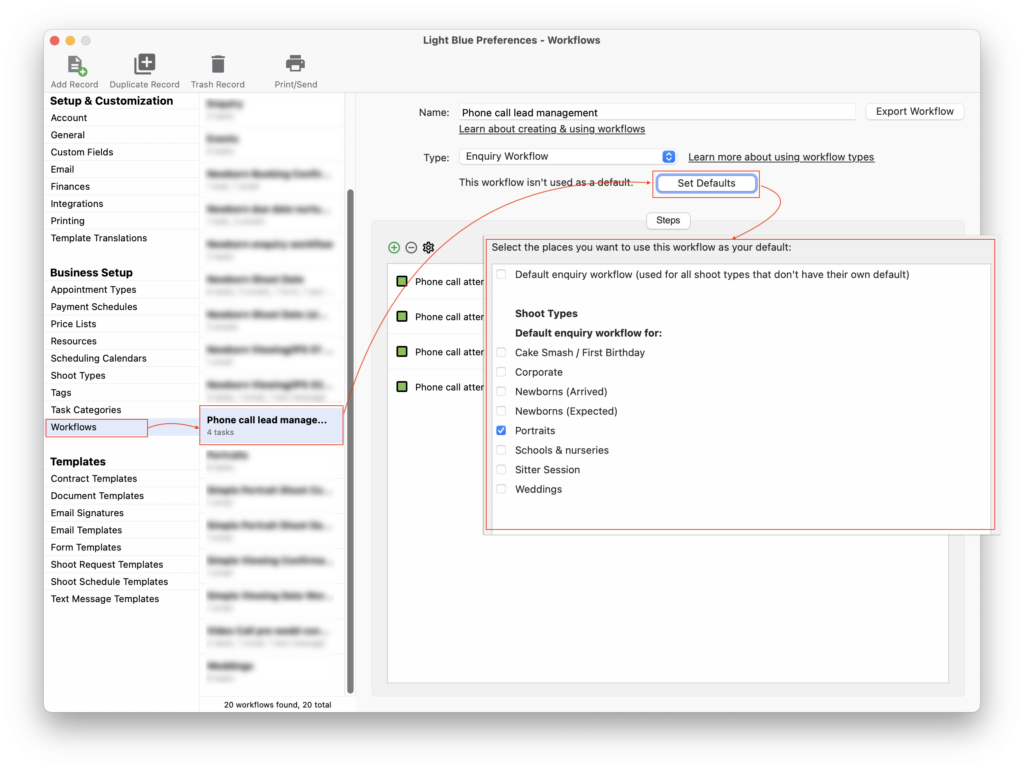
Making phone calls from within the Light Blue desktop app
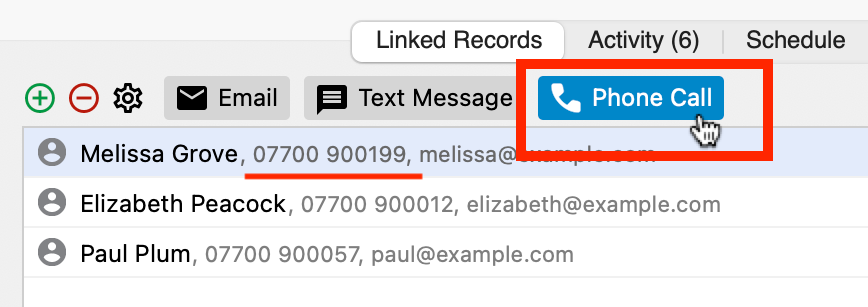
To save time and avoid dialling wrong numbers, you could turn on Light Blue’s Phone Call button in the desktop app, which would allow you to start phone calls using a linked phone or VOIP system.
The booking process
While you are on the phone with the lead, you are trying to get them to commit to a session with you. That involves agreeing on a date and time for the session, and probably also getting them to pay a fee. Here’s a few different ways to approach that:
a. Sending a scheduling request link in an SMS during the call.

If the lead’s ready to book during the call, you could send a text message from a template from within Light Blue. The template would include a scheduling request link which adds a session to the existing shoot record. You can stay on the call and guide them through the process of picking a date and completing payment.

b. Completing a scheduling request yourself during the call.
Instead of sending a scheduling request link to the lead during the call, you could add a scheduling request to the shoot without sending an email/text message. You can then open the scheduling request URL yourself and complete the details while you’re on the phone with the lead.
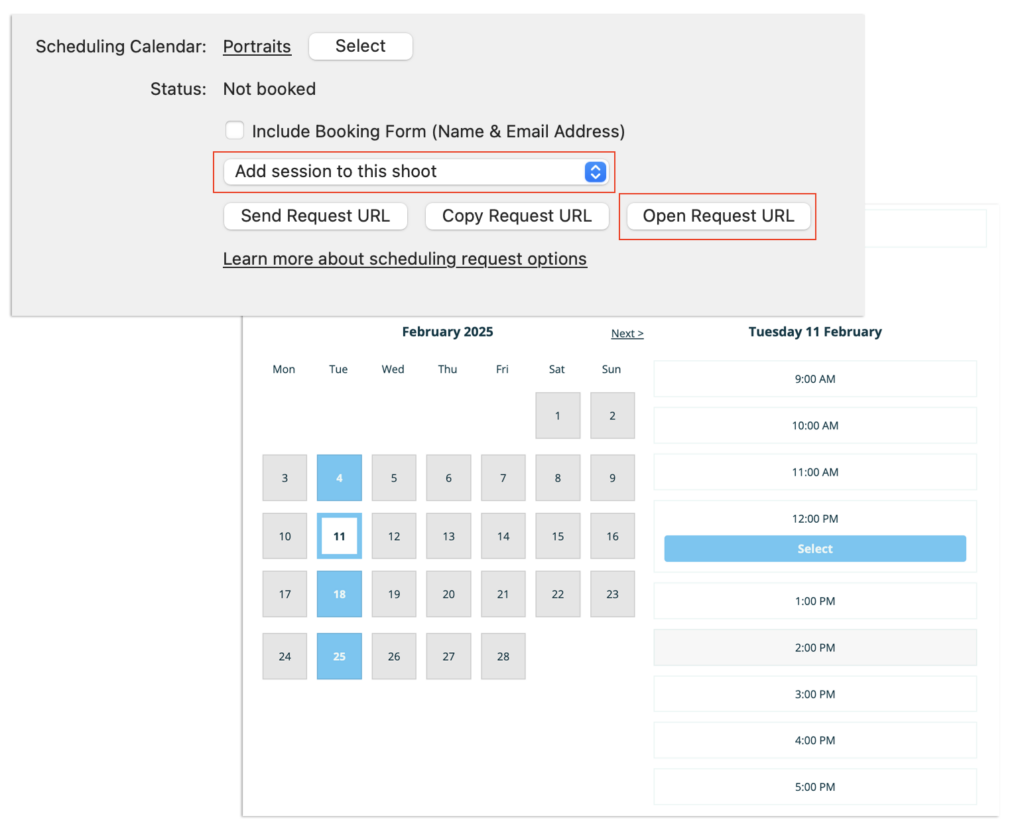
This has the advantage of keeping the conversation flowing naturally.
c. Adding details manually to Light Blue, then sending an invoice.
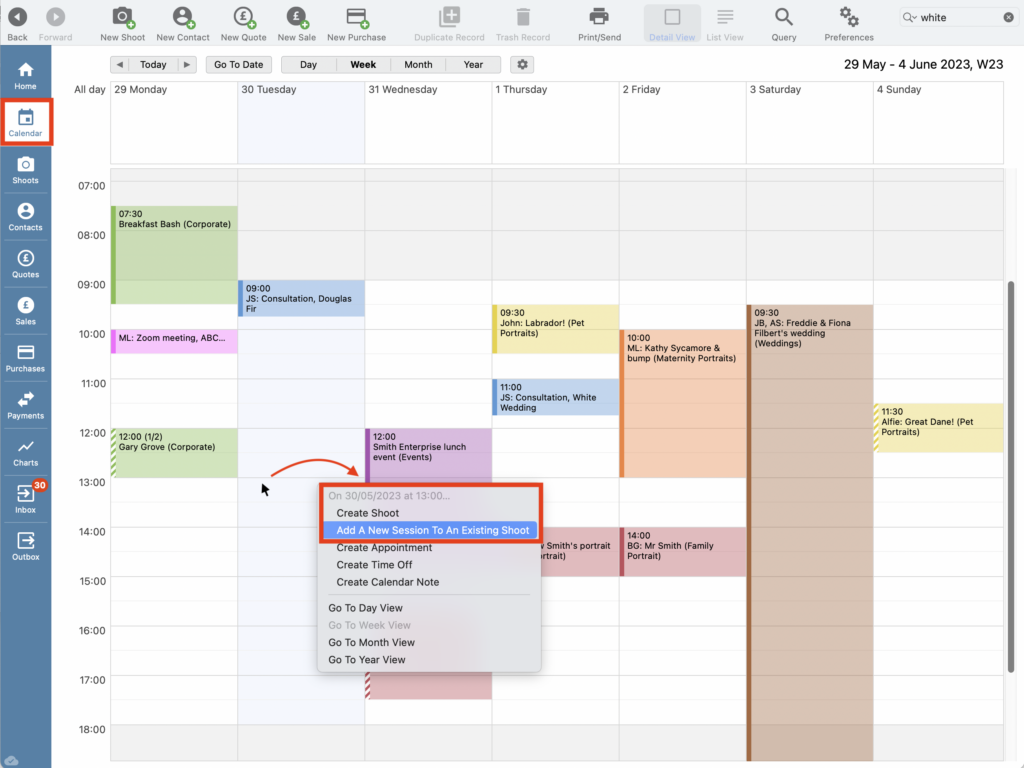
Another option for booking leads over the phone is to use the calendar view within Light Blue’s desktop app. You can find an appropriate date for the session, the right click or double click on the chosen time (the day or week view work best for this), and choose to “Add a new session to an existing shoot”. You can link the session to the shoot record for the lead.
To take payment, you could then add a sale to the shoot record for the booking fee and send the invoice to the client for them to pay.
Health warning: Taking payment details over the phone
If you’re taking payment details over the phone, we strongly recommend that you don’t enter them yourself. Light Blue’s online payment options—via invoices, scheduling calendars, and contracts—are designed for clients to enter their own details securely. Manually inputting payment details on their behalf, especially when they’re not present, may violate the terms of service and best practices of your payment processor (Stripe, Square, and PayPal). To stay compliant and protect client security, always direct them to complete payments through the provided online links, or consider using a POS terminal.
Once the booking’s been made
Once the shoot date’s been set and the status has been marked as “Confirmed”, Light Blue will add the shoot type’s default Confirmation & Shoot Date workflows, which might include an automatic “Thanks for booking me” message.
Handling stale leads

When all phone call attempts have been completed, the lead will move to the “Stale leads” query on the “Phone Call Lead Management” home screen.

At this stage, update the shoot’s status to “Cancelled” and enter a relevant “Cancel reason” (e.g., “Stale lead”). Since the lead has cooled, they may need nurturing before they’re ready to book. If they’ve opted into your mailing list, you can add them to a nurture sequence to re-engage them.
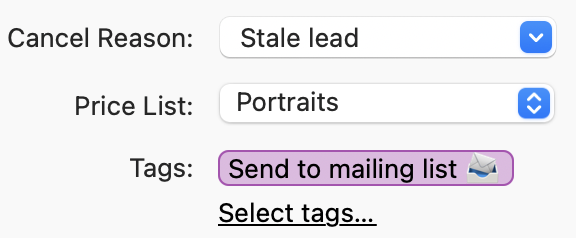
To send them to your mailing list, either export tagged records as a CSV for manual import or use Zapier to automate the process.